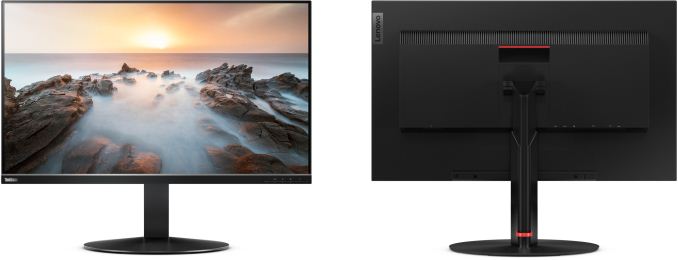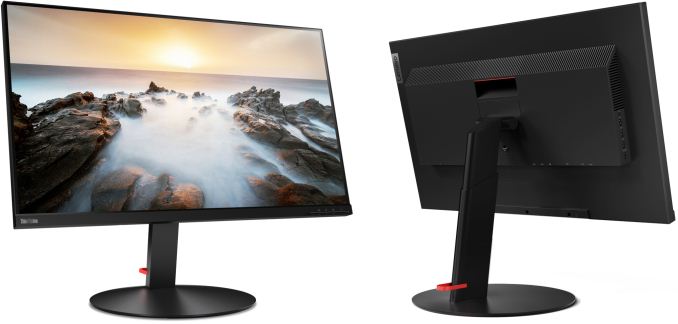Lenovo Announces ThinkVision P32u LCD: 32-inch, 4K, TB3 with Daisy Chaining
by Anton Shilov on January 4, 2018 12:02 AM EST
Ahead of CES, Lenovo is introducing its new ThinkVision P32u professional-grade display. The latest monitor from the company offers an Ultra HD resolution, a wide color gamut, as well as Thunderbolt 3 with daisy chaining, allowing users to to connect further TB3 devices and monitors downstream of the P32u.
Like most professional displays nowadays, the ThinkVision P32u is equipped with an IPS panel featuring an antiglare coating. The latter measures 32”, has a 4K UHD (3840×2160) resolution, a 300 nits brightness, a 1000:1 contrast ratio, a 6 ms GtG response time, 178°/178° viewing angles as well as a 60 Hz maximum refresh. The monitor covers 99.5% of the AdobeRGB color space, which means that its capabilities exceed those required to display 100% of the sRGB spectrum. The company also notes that the monitor supports a “multi-color space capability”, but it's not clear right now whether that capability means that the monitor can display content in different color spaces simultaneously side-by-side in PBP/PiP modes (like some other professional displays), or whether it means something else entirely.
The specs of the ThinkVision P32u hardly look special for a professional monitor as there are numerous 4K models with 99% AdobeRGB coverage for designers and photographers these days. Moreover, its brightness and contrast may be considered too low by the target audience. The key feature of the Lenovo ThinkVision P32u appears to be its connectivity. In addition to the usual DisplayPort 1.2 and HDMI 2.0 inputs, the new monitor has a Thunderbolt 3 input and a Thunderbolt output that can be used to daisy chain another ThinkVision P32u (or a different TB3-enabled monitor), a high-end external storage sub-system, or any other TB3 device. While the Thunderbolt 3 technology has been on the market for 2.5 years now, the number of displays supporting TB3 daisy chaining is limited, so the feature will be an indisputable trump of the ThinkVision P32u. Meanwhile, Lenovo does not forget about widespread USB Type-A peripherals and the new display features a quad-port USB 3.0 hub (one connector supports charging).
When it comes to physical features and ergonomics, the ThinkVision P32 has rather thin bezels and comes with a detachable stand that offers height, tilt, swivel and pivot adjustments along with a red cable management bracket.
| Specifications of Lenovo's ThinkVision P32u Display | ||
| ThinkVision P32u | ||
| Panel | 32" IPS | |
| Native Resolution | 3840 × 2160 | |
| Maximum Refresh Rate | 60 Hz | |
| Response Time | 16 ms | |
| Brightness | 300 cd/m² | |
| Contrast | 1000:1 | |
| Viewing Angles | 178°/178° horizontal/vertical | |
| Pixel Pitch | 0.1845 × 0.1845 mm | |
| PPI | 137 | |
| Color Gamut | 99.5% AdobeRGB 100% sRGB (?) |
|
| Inputs | 1 × DisplayPort 1.2 2 × HDMI 2.0 1 × Thunderbolt 3 input 1 × Thunderbolt 3 output |
|
| Audio | 3.5-mm headphone jack | |
| Color | Black and grey | |
| Power Consumption | Standby | unknown |
| Typical | 70 W | |
| Maximum | 200 W (possibly when upstreaming power to a powerful laptop + charging a smartphone using a USB port) | |
Lenovo plans to start selling its ThinkVision P32u display in March for $1349.
Related Reading
- Lenovo Launches New ThinkPad Accessories: Docking And Displays
- LG Announces the 5K UltraWide 34WK95U: A 'Nano IPS' Monitor with a HDR600 Badge
- LG Develops ‘Nano IPS’ LCD, Unveils 32UK950 4K Display with DCI-P3, HDR600, TB3
- BenQ Launches the SW271 Display for Professionals: 27-inch 4K with HDR and DCI-P3
- Philips Demos 328P8K: 8K UHD LCD with Webcam, Docking, Coming in 2018
- Lenovo Announces New ThinkStation P520/P520C and ThinkPad 52s: Up to 18 Core Xeon-W, Quadro Graphics
- Lenovo Launches Yoga 920 Convertible: 13.9” 4K LCD, 8th Gen Core i7, TB3, 3 Pounds
- Lenovo Unveils ThinkStation P320 Tiny SFF Workstation
- Lenovo Updates ThinkStation P320 with Intel Xeon E3 v6 and NVIDIA Quadro Pascal


















29 Comments
View All Comments
abrowne1993 - Thursday, January 4, 2018 - link
3840x1920? You sure about that?alexvoda - Thursday, January 4, 2018 - link
Was about to ask about that too. That sounds like a very weird resolution.WinterCharm - Thursday, January 4, 2018 - link
Fixed now. It's saying 3840 x 2160bubblyboo - Thursday, January 4, 2018 - link
Response time of 16ms? That's pretty slow even for a "professional" monitor.Unless Lenovo is reporting actual response times now.
StevoLincolnite - Thursday, January 4, 2018 - link
Almost. But no thanks at only a paltry 60hz.CharonPDX - Thursday, January 4, 2018 - link
It's a professional display, not a gaming display. 60 Hz is the standard for everything but gaming. You're not the target market for it, and you should know it, so no need to complain about it.p1esk - Thursday, January 4, 2018 - link
It's 2018. 60Hz should die, period.boeush - Thursday, January 4, 2018 - link
60 Hz at 4k is the equivalent of 240 Hz at FHD, in terms of the number of pixels refreshed per second...Inteli - Thursday, January 4, 2018 - link
Why should it? If 60 Hz is satisfactory for most users, what's the point in doing away with it? A higher refresh rate would simply drive up prices needlessly for most users. There are very few non-gaming use cases I can imagine for >60 Hz refresh rates, and all of them are because 60 isn't a multiple of the standard frame rate for movies.p1esk - Thursday, January 4, 2018 - link
I bet when they had those tiny monochrome displays with 1Hz refresh rate back in the 60s, most "professional" users were satisfied.